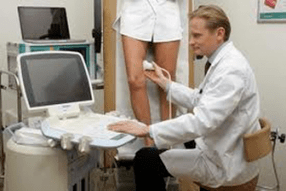Many people mistakenly believe that varicose veins are only a threat to the appearance of the legs. In fact, everything is more serious - this disease is often complicated by thrombosis and inflammation of the deep veins, and in advanced cases - chronic venous insufficiency, which is manifested by pronounced trophic changes in the tissues. Therefore, it is necessary to diagnose this pathology in the initial stages in order to prevent the development of dangerous conditions.

Varicose veins are a pathological change in the walls of venous vessels, which occurs under the influence of blood accumulated in them. Most often, this process develops in the veins of the legs and small pelvis. Normally, the blood through the veins goes only to the heart, this is facilitated by the venous valves and muscles, which, with their contractions, seem to "drive" blood through the vessels. With varicose veins, for various reasons, abnormal blood flow is formed. It begins to stagnate first in the deep veins, and then in the superficial ones, which increase, forming varicose veins under the skin.
Symptoms of varicose veins of the lower extremities.
The first signs of this disease are nonspecific (they are also found in other diseases), they are combined under the term "heavy legs syndrome". It is characterized by increasing and progressive fatigue of the lower extremities, pain in the legs, sensation of heaviness, burning and popping in the calves, nocturnal cramps in the calf muscles. These symptoms appear at the end of the day, especially if the person has been standing or sitting for a long time during the day. Subsequently, with the development of pathology, nocturnal swelling of the back of the foot and ankles is added to the described manifestations of the disease. After rest, the condition of the sore legs usually improves.
Visual changes in the early stages of the disease are not always noticeable, since varicose veins in the legs begin with deeper vessels. The only outward sign of a problem that has started may be the vascular networks. Of course, they do not always indicate varicose veins, but it is better to consult a phlebologist, a specialist in vein diseases, when they appear.

But in the later stages of varicose veins, cyanotic subcutaneous veins and varicose nodules, which are enlarged and tortuous surface veins that resemble grapes, already appear. They are usually found on the inside of the lower leg and thigh.
Also, with the progression of the pathology, the legs begin to swell more. Gradually, chronic venous insufficiency is formed, in which the venous outflow and microcirculation in the tissues is disturbed. All this is reflected in the condition of the skin on the legs: it darkens, peels, itches, then trophic ulcers appear, which heal very poorly. This is how varicose veins develop. A similar result of varicose veins can be prevented with timely treatment, therefore, if slight but systematic discomfort appears on the legs and vascular networks or "stars" on the skin, you should consult a doctor.
Symptoms of pelvic varicose veins
In the pelvis, varicose veins are less common than in the legs and predominantly in young women. The trigger for the development of this pathology is pregnancy (both hormonal and mechanical factors play a role here). After childbirth, the signs of the disease, as a rule, disappear, and only about 10% of women notice a periodic resumption of unpleasant symptoms after prolonged standing, hypothermia and physical exertion.
Varicose veins of the small pelvis are manifested by chronic pelvic pain, as well as the expansion of superficial venous formations in the perineum and vulva. Such patients often unsuccessfully treat inflammatory diseases of the reproductive organs, since pain in the lower abdomen, characteristic of pelvic varicose veins, is sometimes mistakenly associated with chronic oophoritis, salpingitis, endometriosis, etc.
How are varicose veins diagnosed?
When varicose nodes become clearly visible on the patient's legs, the doctor can make a diagnosis of "varicose disease" even without the results of instrumental studies. If the pathology is just beginning to develop or is localized in the small pelvis, an in-depth examination is indispensable.

The main method for diagnosing varicose veins is Doppler ultrasound. This study is informative for vein injuries anywhere in the body. With the help of ultrasound, the doctor can study the condition of the walls and the anatomy of the deep and superficial veins, valves, assess the blood flow in the vessels, detect blood reflux, etc. The classification of varicose veins and, accordingly, the choice of treatment method is based precisely on the results of ultrasound.
Another diagnostic method used in this pathology is reovasography. Its implementation allows you to determine how well the tissues of the lower extremities are filled with blood and nutrients. This information helps the doctor to determine at what stage the disease is: in the stage of compensation, subcompensation, etc.
Less often, phlebography is used for varicose veins - this is an X-ray examination of the veins with contrast.
Also, a full examination of patients with varicose veins usually includes various blood tests: doctors are especially interested in the level of hemoglobin, erythrocytes, platelets, and coagulogram parameters. These data make it possible to assess the density of the blood and the tendency of the patient's body to form blood clots.


















